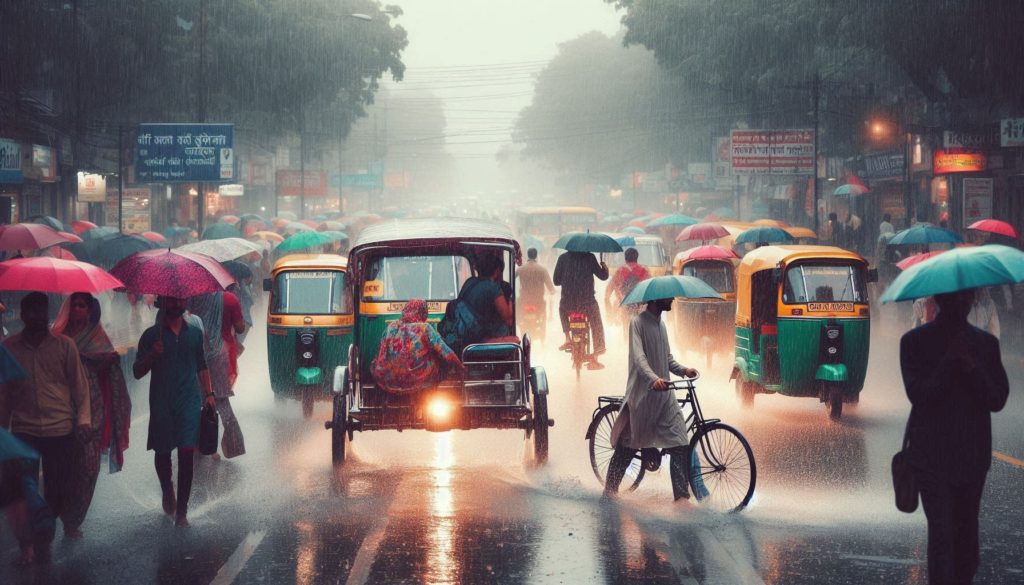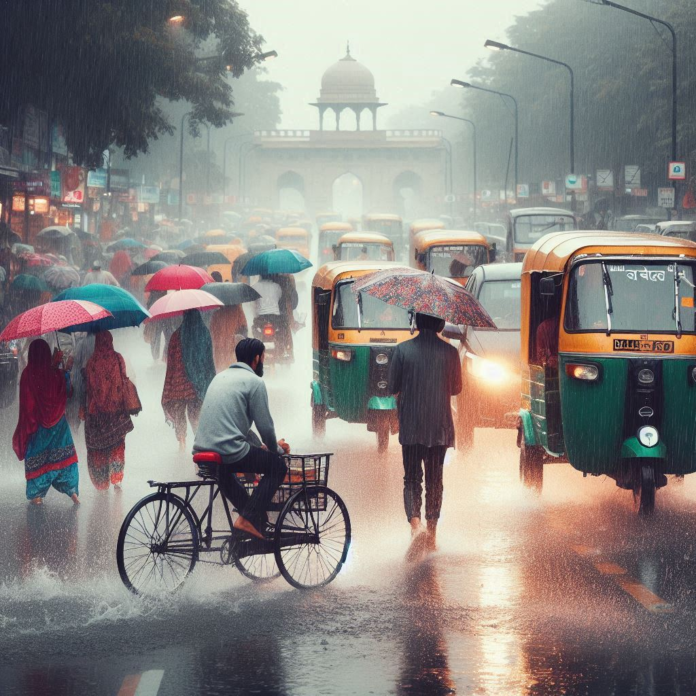Delhi Rain
Delhi Rain : Delhi has been hit by heavy rainfall, resulting in widespread waterlogging and significant disruptions across the city. The Indian Meteorological Department (IMD) had issued warnings predicting more showers, and the capital experienced a substantial downpour that started in the early hours and continued throughout the day. The rains have not only led to traffic snarls but also caused severe waterlogging in several parts of Delhi, including major roads and low-lying areas, leading to a standstill in many places.

The Impact of Delhi Rain
The delhi rain, which began early in the morning, quickly escalated to a heavy downpour, affecting daily life significantly. Major roads such as the Ring Road and areas around ITO witnessed severe waterlogging, which led to traffic jams and slowed down vehicular movement. Commuters faced delays as the city’s infrastructure struggled to cope with the volume of water, which overwhelmed drainage systems in many parts of the city.
Several schools in Delhi were closed as a precaution due to the weather conditions. The decision to close schools was made by the authorities in light of the forecast for continued rain and the potential hazards posed by waterlogged streets and traffic disruptions. This measure aimed to ensure the safety of students, who would otherwise have had to navigate the treacherous conditions to get to school.
Meteorological Predictions and Warnings Delhi Rain
The IMD has been closely monitoring the weather patterns, and today’s rainfall was anticipated as part of an ongoing spell of monsoon showers affecting northern India. The department had issued warnings for heavy rainfall, urging citizens to be cautious. According to the forecast, the city was expected to experience not just sporadic showers but also periods of intense rain, which indeed materialized, leading to the challenging conditions observed.
The IMD’s predictions for the day included not only heavy rain but also the possibility of thunderstorms. These warnings are part of a broader weather pattern affecting much of the northern region of India, where the monsoon is in full swing. The continuous rains are a result of the monsoon trough that is currently positioned over the region, causing moist winds from the Arabian Sea and the Bay of Bengal to converge over the northern plains, including Delhi.
Delhi Rain : The Effects of Waterlogging and Infrastructure Challenges
Waterlogging is one of the most significant issues caused by today’s Delhi rain. In areas such as Minto Bridge and near the AIIMS flyover, the accumulation of water was so severe that it led to partial submersion of vehicles. Emergency services and the local administration were on high alert, with teams deployed to clear waterlogged areas and assist stranded commuters.
Delhi’s infrastructure, especially its drainage system, has long struggled to handle heavy delhi rainfall. Despite various efforts by the city’s municipal authorities to improve drainage, the city continues to face severe waterlogging during the monsoon season. The inadequacies of the drainage system are exacerbated by the high rate of urbanization, which has reduced the natural absorption of rainwater, leading to faster runoff and increased flooding.
Traffic Disruptions and Commuter Woes
The impact on traffic was immediate and widespread. Key roads and intersections became choke points as vehicles struggled to move through waterlogged streets. Public transportation was also affected, with buses and auto-rickshaws either delayed or rerouted to avoid the worst-affected areas. The Delhi Metro, a crucial lifeline for many commuters, also faced issues, though it remained operational with minor delays reported on some lines.
For many Delhiites, the rain brought back memories of past monsoon seasons, where similar conditions had caused havoc in the city. Commuters took to social media to share their experiences, with many expressing frustration over the recurrent issue of waterlogging and the lack of effective solutions from the city’s administration.
Response from Authorities and Future Outlook
The Delhi government and civic bodies have been working to address the immediate impacts of the rainfall. Pumps were deployed in critical areas to remove accumulated water, and traffic police were on the ground managing the congestion. However, the heavy rain has highlighted the ongoing challenges the city faces in managing monsoon-related disruptions.
Looking ahead, the IMD has indicated that more rain is likely in the coming days as the monsoon continues its course. Citizens have been advised to stay indoors as much as possible and to avoid areas known for severe waterlogging. The city’s response to today’s rain will be closely watched as it could set the tone for how the remainder of the monsoon season will be managed.
Conclusion
Today’s heavy delhi rainfall has once again exposed the vulnerabilities of the city’s infrastructure to monsoon weather. Despite warnings and preparations, the rain led to significant waterlogging and disruptions, affecting the daily lives of the city’s residents. As the monsoon season progresses, it remains to be seen how effectively the city will be able to cope with similar challenges in the future. The experiences of today underscore the need for long-term solutions to improve the city’s drainage system and to mitigate the impacts of heavy rainfall on urban life.



